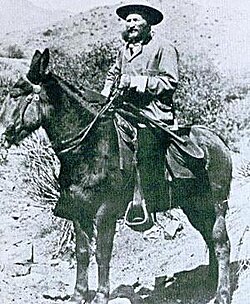
Wickenburg is a town in Maricopa and Yavapai counties, Arizona, United States. The population was 7,474 at the 2020 census, and was estimated to be 7,920 in 2022.

George R. Crook was a career United States Army officer who served in the American Civil War and the Indian Wars. He is best known for commanding U.S. forces in the 1886 campaign that led to the defeat of the Apache leader Geronimo. As a result, the Apache nicknamed Crook Nantan Lupan, which means "Chief Wolf."

The Western Apache are a subgroup of the Apache Native American people, who live primarily in east central Arizona, in the United States and north of Mexico in the states of Sonora and Chihuahua. Most live within reservations. The Fort Apache Indian Reservation, San Carlos Apache Indian Reservation, Yavapai-Apache Nation, Tonto Apache, and the Fort McDowell Yavapai Nation are home to the majority of Western Apache and are the bases of their federally recognized tribes. In addition, there are numerous bands. The Western Apache bands call themselves Ndee (Indé). Because of dialectical differences, the Pinaleño/Pinal and Arivaipa/Aravaipa bands of the San Carlos Apache pronounce the word as Innee or Nnēē:.

The Apache Wars were a series of armed conflicts between the United States Army and various Apache tribal confederations fought in the southwest between 1849 and 1886, though minor hostilities continued until as late as 1924. After the Mexican–American War in 1846, the United States annexed conflicted territory from Mexico which was the home of both settlers and Apache tribes. Conflicts continued as American settlers came into traditional Apache lands to raise livestock and crops and to mine minerals.

The Tonto Apache Tribe of Arizona or Tonto Apache is a federally recognized tribe of Western Apache people located in northwestern Gila County, Arizona. The term "Tonto" is also used for their dialect, one of the three dialects of the Western Apache language, a member of Southern Athabaskan language family. The Tonto Apache Reservation is the smallest land base reservation in the state of Arizona.

The Camp Grant massacre, on April 30, 1871, was an attack on Pinal and Aravaipa Apaches who surrendered to the United States Army at Camp Grant, Arizona, along the San Pedro River. The massacre led to a series of battles and campaigns fought between the Americans, the Apache, and their Yavapai allies, which continued into 1875, the most notable being General George Crook's Tonto Basin Campaign of 1872 and 1873.

The Apache Scouts were part of the United States Army Indian Scouts. Most of their service was during the Apache Wars, between 1849 and 1886, though the last scout retired in 1947. The Apache scouts were the eyes and ears of the United States military and sometimes the cultural translators for the various Apache bands and the Americans. Apache scouts also served in the Navajo War, the Yavapai War, the Mexican Border War and they saw stateside duty during World War II. There has been a great deal written about Apache scouts, both as part of United States Army reports from the field and more colorful accounts written after the events by non-Apaches in newspapers and books. Men such as Al Sieber and Tom Horn were sometimes the commanding officers of small groups of Apache Scouts. As was the custom in the United States military, scouts were generally enlisted with Anglo nicknames or single names. Many Apache Scouts received citations for bravery.

Al Sieber was a German-American immigrant who fought in the American Civil War (1861-1865), and in the American Old West frontier against the Native Americans. (Indians) in the later American Indian Wars of the mid to late 19th century. He became a prospector and later served as a decorated Chief of Scouts for the United States Army during the subsequent Apache Wars of 1849 - 1886 in the southwestern United States.

The Yavapai are a Native American tribe in Arizona. Their Yavapai language belongs to the Upland Yuman branch of the proposed Hokan language family.

George Morton Randall was a major general in the United States Army, noted for his service in the American Civil War and Indian Wars. He was born in Conneaut, Ohio, the son of Brewster Randall (1807–1880) and Harriet Eliza Fifield Randall (1819–1878).

William Allen was a U.S. Army soldier who fought during the Indian Wars in the post-American Civil War period. Serving under Lieutenant Colonel George Crook, he participated in expeditions against the Apache in the Arizona Territory throughout the 1870s. He was one of four men who received the Medal of Honor for the Battle of Turret Peak against the Yavapai Apaches in 1873.
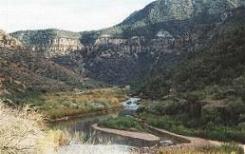
The Battle of Salt River Canyon, the Battle of Skeleton Cave, or the Skeleton Cave Massacre was the first principal engagement during the 1872 Tonto Basin Campaign under the command of Lieutenant Colonel George Crook. It was part of the Yavapai War from 1871 to 1875 against the Yavapai people, a Native American tribe in Arizona.

Nantaje, also called Nantahe, was an Apache Indian scout in the U.S. Army who served under Lieutenant Colonel George Crook during the Apache Wars. He guided cavalry troopers against renegade Apaches in the Arizona Territory during Crook's winter campaign of 1872-73 and was one of ten scouts who later received the Medal of Honor for gallantry.

The Battle of Pecos River was fought in 1864 during the Navajo Wars. United States Army troops and Apache Scouts defeated a force of Navajo warriors next to the Pecos River in New Mexico. It is notable for being one of the many Indian war battles involving the California Column.
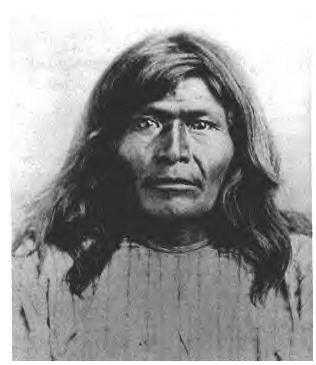
Victorio's War, or the Victorio Campaign, was an armed conflict between the Apache followers of Chief Victorio, the United States, and Mexico beginning in September 1879. Faced with arrest and forcible relocation from his homeland in New Mexico to San Carlos Indian Reservation in southeastern Arizona, Victorio led a guerrilla war across southern New Mexico, west Texas and northern Mexico. Victorio fought many battles and skirmishes with the United States Army and raided several settlements until the Mexican Army killed him and most of his warriors in October 1880 in the Battle of Tres Castillos. After Victorio's death, his lieutenant Nana led a raid in 1881.
First Sergeant Rudolph Stauffer was a Swiss-born American soldier in the U.S. Army who served with the 5th U.S. Cavalry in the Apache Wars. He was one of twelve soldiers, along with ten Apache Scouts, awarded the Medal of Honor during Lieutenant Colonel George Crook's "winter campaign" of 1872–73, being cited for gallantry in battle against renegade Apaches near Camp Hualpai. Charles King, while serving with the 5th U.S. Cavalry in his youth, wrote of him in his memoirs as "grim old Stauffer, the first sergeant".
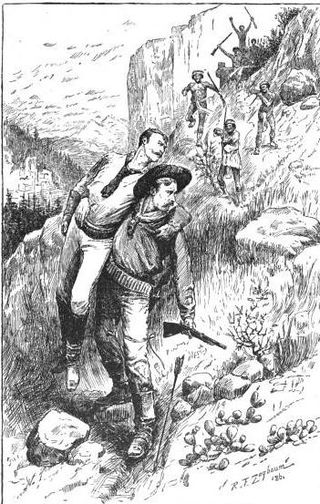
The Battle of Sunset Pass was fought in November 1874 during the Yavapai War. Following the theft of livestock by a band of Tonto Apaches, a troop of United States Army soldiers was dispatched to track the natives and recover the stolen property. The Americans found the raiders at Sunset Pass, in Coconino County, Arizona, where a small skirmish ensued.
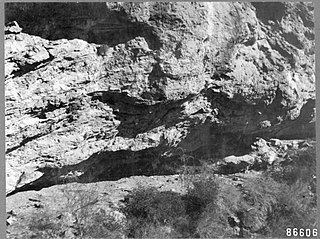
The Yavapai Wars, or the Tonto Wars, were a series of armed conflicts between the Yavapai and Tonto tribes against the United States in the Arizona Territory. The period began no later than 1861, with the arrival of American settlers on Yavapai and Tonto land. At the time, the Yavapai were considered a band of the Western Apache people due to their close relationship with tribes such as the Tonto and Pinal. The war culminated with the Yavapai's removal from the Camp Verde Reservation to San Carlos on February 27, 1875, an event now known as Exodus Day.
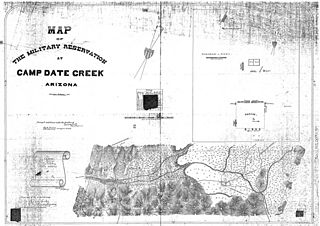
The Hualapai War, or Walapai War, was an armed conflict fought from 1865 to 1870 between the Hualapai native Americans and the United States in Arizona Territory. The Yavapai also participated on the side of the Hualapai and Mohave scouts were employed by the United States Army. Following the death of the prominent Yavapai leader Anasa in April 1865, the natives began raiding American settlements which provoked a response by the United States Army forces stationed in the area. By the spring of 1869 disease forced the majority of the Hualapais to surrender though some skirmishing continued for almost two more years.

The Pinal Mountains are a mountain range located in Gila County, Arizona. They have a maximum elevation of 7,848 ft (2,392 m) at Pinal Peak and a prominence of over 4,000 ft (1,200 m). The closest city is the Globe, Arizona/Miami, Arizona area, which is just a few miles north of the mountain range. The mountains are located within the Tonto National Forest, and their recreational facilities are maintained by the USDA's United States Forest Service. The San Carlos Indian Reservation is very close to the mountain range, with its boundaries being just a few miles east/northeast of the range. The mountains are covered with Ponderosa Pine and white fir and experience cooler weather than the Globe/Miami area, so that they are a popular recreation area in the summer. The maintained facilities include a maintained dirt road that goes all the way to the summit of Pinal Peak, a campsite and recreational area, many hiking trails, as well as some radio towers near both Pinal and Signal peaks. The mountain range covers an area of 45,760 acres.
